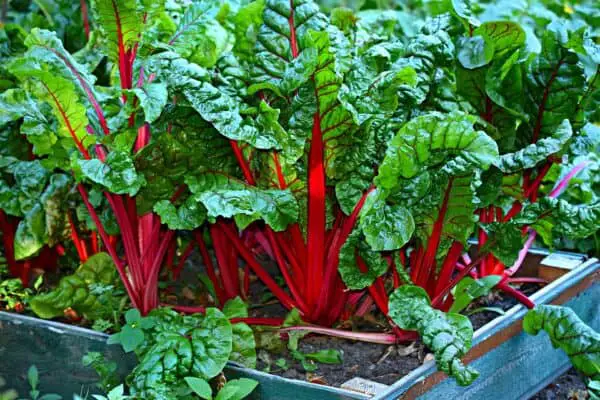
Swiss chard can be fed to tortoises as part of a varied and balanced diet. Like many plants, swiss chard is high in oxalic acid, which is known to contribute to the formation of kidney stones when consumed in large quantities. Chard should therefore be fed sparingly, in combination with other foods, and only when the tortoise is sufficiently hydrated.
What is Swiss Chard?
Commonly found in pre-prepared salad mixes, swiss chard (or simply chard) is a plant characterised by its green leaves which feature red veins and petioles (stalks). Chard falls under the same family of plants that include beets (beetroot).
Chard is widely regarded to be a very healthy food thanks to its high concentration of various essential nutrients. Just as this makes it very healthy for humans to eat, the same is true of tortoises, so long as you know when and how much of it to provide.
Can Chard Be Offered to Tortoises?
First and foremost, chard certainly can be fed to tortoises, and it contains a whole range of essential vitamins and minerals including:
- Vitamin A
- Vitamin B1, B2, B3, B4, B5, and B6
- Vitamin E
- Vitamin C
- Vitamin K
- Calcium
- Iron
- Zinc
- Potassium
All of which are needed for the various biological processes a tortoise’s body needs to undertake in order to survive.
The main downside to feeding your tortoise chard is that it contains an ‘anti-nutrient’ called oxalic acid. Let’s look in a little more detail at this substance using human consumption of it as an example.
The issue of whether foods such as chard that are high in oxalic acid (or ‘oxalates’) can be eaten in large quantities by humans is a contentious one. These days even people who have been afflicted by kidney stones are not generally instructed to reduce their intake of chard or other foods high in oxalic acid, simply because the benefits of eating such produce may well outweigh the risks.
The reason this may be so is because it is known that the majority of oxalates present in the kidneys/urine are produced in the body, rather than absorbed from food. In other words, genetic predisposition may play a greater role than diet in the risk of developing kidney stones.
Therefore, as ever, things are not quite as simple as they might first seem!
Now, the reason for this mini lesson in human digestive biology is really a long winded way of saying that the same risk/benefit scenario may well be true for tortoises.
The fact is that almost all leafy green produce, from dandelion, to plantain or chard, all contain moderate to high levels of oxalic acid, yet for tortoises consuming such plants as the staples of their diet is not generally harmful.
Other factors must therefore be at play.
The Importance of Hydration When Feeding Chard
The golden rule before offering your tortoise just about anything beyond foods such as lettuce or cucumber (which have a high water content), is to ensure that you do all you can to supplement their fluid intake.
Once again, in humans the number one recommendation from doctors for anyone who has experienced a kidney stone is to get into the habit of drinking plenty of water, thereby keeping their urine dilute, and continually flushing the body of excess anti-nutrients such as oxalates.
The same is true of tortoises, whether by them voluntarily drinking, or by your encouragement with routine soakings. Indeed regularly soaking your tortoise is almost universally considered to be good practice by those in the tortoise keeping community, myself included.
Chard as Part of a Balanced Diet
Some evidence suggests that another issue with eating foods high in oxalates can reduce mineral absorption by the gut when combined with high fiber foods, or if the food itself contains a lot of fiber.
Compared to other plants typically fed to tortoises, chard has a relatively low fiber content at 2.1 grams per 100 grams, but at the same time it contains one of the highest concentrations of oxalate per 100 grams at 734.7mg per 100 grams.
For comparison, dandelion leaves (a firm favourite among tortoise’s and their owners) is relatively high in fiber at 3.5 grams per 100 grams, yet it has a much lower oxalate level at just 24.6mg per 100 grams.
So it seems the drawback of chard may be that its oxalate content may be an issue when consumed with higher fiber foods such as dandelion. Or should that be that the drawback of dandelion is that its high fiber content may be an issue when consumed with high oxalate foods such as chard.
So what should we take away from this? Well, it’s tricky to say in real world terms, but if I had to make an educated decision I would suggest that a diet rich in low oxalate foods such as dandelion and broadleaf plantain is a good basis to begin with.
Then keep in mind that the occasional sprinkling of higher oxalate foods such as chard should absolutely continue because they contain valuable nutrients, and because the old mantra of a varied and balanced diet is as true now as it ever was.
Indeed, some studies even suggest advantages to consuming some oxalates, for example because of a potential benefit to the immune system. However, knowing the sweet spot for this is very difficult, hence why it is a good idea to simply vary what you feed your tortoise so that they don’t consume too much of one thing.
Even ‘good’ nutrients can reach harmful levels if enough of them are consumed.
Conclusion
Chard is certainly edible and contains a whole range of essential vitamins and minerals that keep your tortoise healthy. Whilst it certainly should not form the basis for your tortoise’s diet, it can be used to add variety and interest alongside other foods, and crucially, as long as your tortoise is adequately hydrated.

